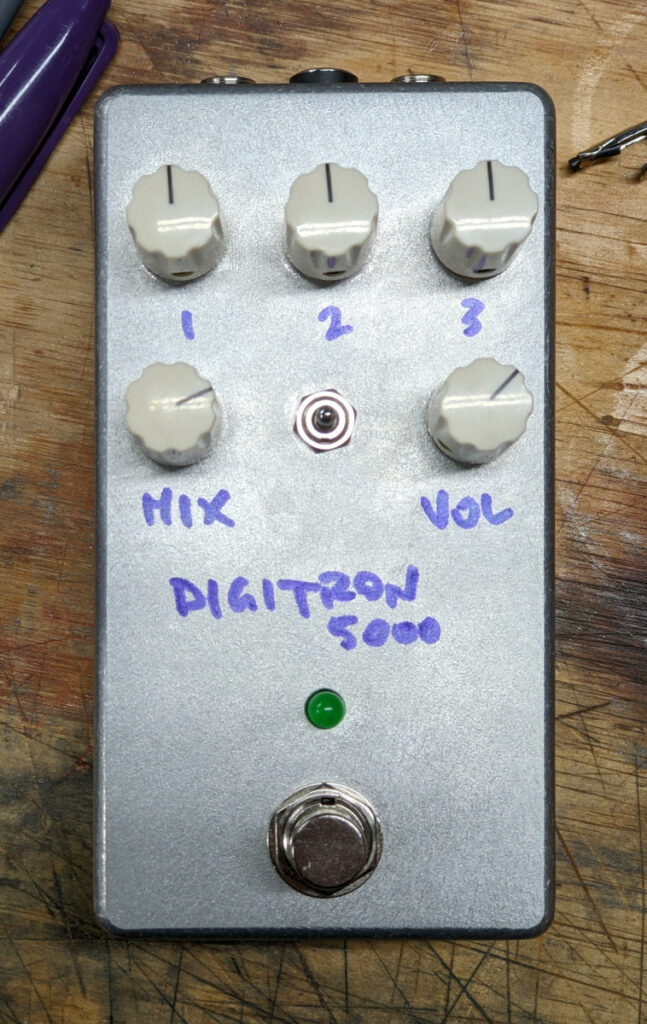

My Newport Folk Festival
It was at the Newport Folk Festival in 1965 that Bob Dylan proceeded to plug his guitar into an electrical outlet and as a result, like one writer phrased it, electrified one half of his audience and electrocuted the other.
John Gilrand, “Ballad in Plain D: An introduction to the Bob Dylan era”
I have apparently gone digital. The good news for me is that I have no audience to be upset by it.
It’s also overstating it by quite a bit. I don’t really have anything against digital, and have messed with it several times before. Technically, anything with a PT2399 or Belton Brick is digital-ish (like my A Weird Amount of Chorus, Vacuous Reverb, Monotonous Delay, etc.) The main reason I haven’t pursued digital effects beyond that was that I thought it was literally impossible for a dilettante builder. Then I built Savage Torpor, which is based on a Spin FV-1. That was next-level digital for me, but in an approachable style, since it came with an EEPROM with reverb patches already on it. In the process of figuring out how that worked, I learned that there is software out there that would let me program digital effects for an FV-1 without having to write hideous machine code in hexadecimal or something similarly arcane. If I’ve said it once, I’ve said it 3E8 times, I’m not writing anything in hex.
To pursue that further, I bring you the DIGITRON 5000: a utility pedal that will allow me to write my own effects to EEPROMs and test them.
Details
What’s that? It has a USB port?
It does have a USB port. This pedal can talk to my computer. Which is wild.
The Spin FV-1 is a chip (and kind of a platform) for digital signal processing. It is somewhat self-contained like a PT2399, in that it does its own analog/digital conversion and stuff, but it’s a lot more powerful and flexible. It can read programs from an external EEPROM (electrically erasable programmable read-only memory), which is really convenient for manufacturers. They can focus on the creative side of digital effects without getting too bogged down in the details of the digital realm, or create one piece of hardware, build a ton of them to take maximum advantage of economy of scale, but still create a broad line of products just by changing the EEPROM. And since it works so well for them, that technology can trickle down to the home builder.
The DIGITRON 5000 is a PedalPCB FV-1 Development PCB. While it can be an effect pedal of its own, its real purpose (and the reason I’ve classified and decorated it as a “Utility Pedal” on this site) is related to its USB port. It’s really for the testing and development of digital effects. Since it will connect to a computer via USB, I can write (or borrow) effect patches on my computer and push them to the EEPROM on the pedal, which can then be run by the FV-1. The EEPROM is socketed, so I could theoretically then put it into another pedal that is dedicated to a specific purpose, just like Savage Torpor. Or I can just use this for one-off effects that I might never need again.
I have no idea where I’ll go with this. A huge part of pedal building for me is that I can do it away from the computer, where I spend the other 97% of my waking hours, and I’m not much of a programmer so I don’t know if this will really take off for me, but it has been a fun experience so far.
Vital Stats
Sound
It’s impossible to capture the full range of sounds of this thing, since it’s basically unlimited. It can do whatever a Spin FV-1 can do.
I did create the following test (within the first 30 minutes of assembling the pedal) just to see if it would go. One of the inspirations for trying this was hearing a guy in Nashville recently play with an EHX Pitchfork, which is a polyphonic pitch shifter and a type of effect that I didn’t think I’d ever be able to make. While this is a clumsy first attempt with some annoying clicking in it, it is technically doing an octave up, octave down, plus a 5th, and the fact that it works at all is amazing to me.
It’s the Coronacaster into the DIGITRON 5000, direct into the interface. It is later joined by the Toynbee (in front of the DIGITRON 5000) for added laser sounds.



